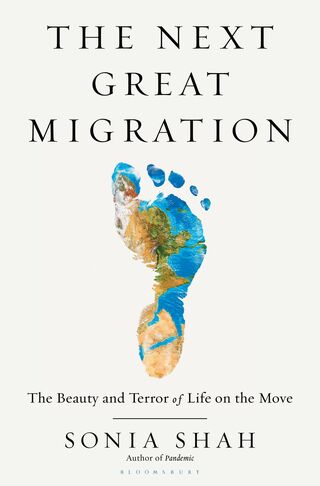Environment
Migration Is Fundamental to Life
Interview with Sonia Shah, author of 'The Next Great Migration.'
Posted December 17, 2020

In her book The Next Great Migration: The Beauty and Terror of Life on The Move, Sonia Shah makes an argument that migration is central to life. As we come to the end of 2020, with its lockdowns and harsh immigration policies, Shah's book offers a new perspective for thinking about the future.
Butterflies are migrating in response to climate change. Genetic evidence suggests that humans have always been migratory. 99% of species newly introduced to an ecosystem adapt harmoniously, rather than becoming "invasive." Here, Shah explains some of the key details of her research—and its implications. In addition to The Next Great Migration, Shah is the author of Pandemic: Tracking Contagions, from Cholera to Ebola and Beyond, The Fever: How Malaria has Ruled Humankind for 500,00 Years, The Body Hunters: Testing New Drugs on the World's poorest Patients, and Crude: The Story of Oil. Her TED talks, "3 Reasons We Haven't Gotten Rid of Malaria" and "How to Make Pandemics Optional, Not Inevitable," have been viewed by more than a million people.
In The Next Great Migration, you make a powerful argument—with a lot of evidence—that migration is a biological necessity for plants and animals—including humans and other mammals, birds, insects, and aquatic creatures. How and when did you first start to realize how central migration is to life?
It was a process of discovery for me. I came to the topic of migration really thinking of it, almost reflexively, as a disruptive phenomenon. That was how I interpreted the role of migration in my own life, and it was also, broadly speaking, the subject of several of my previous books, which in various ways look at the disruptive effects of people, animals, and microbes moving around into new places. In 2015 I was reporting on the public health impact of Syrian and Afghan refugees streaming into southern Europe, when I interviewed an aid doctor working at one of the ad hoc refugee camps that had been set up in Greece to detain newly arrived migrants fleeing bombs and beheadings. My premise was that their movement could pose a public health risk, by introducing novel pathogens into a new disease environment. I asked him something along the lines of, "What are the health implications of this migrant crisis?" And he stopped cold and said to me: "There is no migrant crisis." I found it quite shocking. People were drowning in the Mediterranean, refugee camps had sprung up across the continent, and borders were closing. There was obviously some kind of crisis unfolding. But he went on to explain that there were in fact plenty of jobs and plenty of housing for the newcomers. The crisis, he said, was not about the migrants, but about the people who refused to welcome them. That is to say, it wasn't a "migrant" crisis, but rather a crisis of reception.
I realized then that I had reflexively conflated the fact of movement with crisis, presuming that migration would trigger some kind of catastrophic effect—even before evaluating whether there was absorptive capacity in the places where the migrants were going, or whether their movement might contribute to the resilience of the societies they left behind. Once I realized that, I started to dig into why I'd come to think that way, and discovered a wealth of scientific discoveries that have showcased the centrality of migration in nature and in our own history.
For centuries, migration has provoked a lot of social panic. We worry about so-called invasive plant species. We build walls to keep immigrants out of the U.S. What are some of the origins of social and political attitudes about migration?
The most telling aspect of this phenomenon is that it is quite peculiar, actually. Most of the time, we don't build walls against newcomers, literally or figuratively. Social scientists who study xenophobic sentiment when disparate groups intersect find that it is the exception, rather than the rule. And while the conventional wisdom is that non-native species are uniformly invasive and undesirable, that doesn't take into account the many non-native species that are beloved and nurtured, for example, all of our crop plants, honeybees, earthworms, etc. So it seems we only sometimes object to newcomers. One theory explains this by pointing to the conspicuousness of newcomers. Most of the time, migrants arrive and are quickly absorbed and assimilated, and we barely notice them at all. Most wild species that arrive in new places and establish themselves are similarly unobjectionable: they don't cause any negative impacts to ecosystems, human health or the economy. We don't really notice them either. It may be that the outbursts of xenophobic sentiment that we do see in some places and at some times correlate with situations in which, whether by accident or through policy choices, migrants become conspicuous to us. Think of the purple flowers of loosestrife, which were for years condemned as dangerous invasives and targeted for destruction, or migrants lining up at a border crossing so that their papers can be examined. This spectacle of migration seems to be key to triggering xenophobic and anti-migrant sentiment. That's something within our power to control, and which could inform how we manage migration.
What are some of the salient biological and social benefits of what you describe as “life on the move”?
The movement of wild species is critical to many fundamental ecological processes. The dispersal of seeds, for example, which shapes the abundance and species composition of forests, depends on the movement of birds and other animals. The ability of populations to survive pathogenic threats depends on the genetic diversity that migrants introduce. Without wild migrants, the botanical scaffolding of whole ecosystems could collapse; and wild populations would become insular and more easy to wipe out with, say, a pandemic. In an era of changing climate, future biodiversity itself may rely on the ability of wild species to move into new places.
Human migrants play similarly critical roles by introducing genetic and cultural novelty into host societies, which contributes to their resilience. We also know that migrants are generally healthier than the host population they enter, because migration itself requires good health. And migrants are generally rich in the kinds of qualities that build the middle class. They aren't the poorest of the poor, who cannot afford to move, nor are they the wealthiest, who stand to lose their titles and property if they move. Instead, they're people who have portable capital: skills, resourcefulness, social connections, good health. These are resources that strong societies depend upon.
If you think about migration in the broad view, and how common it is in nature and in our own history, it seems clear that overall, the benefits outweigh the costs.

When it comes to plants and insects, we hear a lot about “invasive species.” The metaphor is telling in the way it borrows from human behavior to imply colonization. The term compels the kind of anxiety you’re talking about—even though the evidence shows that the benefits of migration outweigh the costs. What would you say to a skeptical conservationist who pointed out that the introduction of a vine to an ecosystem is damaging trees or a frog eating other species of frogs who populated an area before they arrived. These are the kinds of stories we hear in the news a lot. Is the introduction of some species to an environment sometimes genuinely damaging? Or do we need a new perspective for thinking about the role of new species in an ecosystem?
There's no doubt that some species cause unwanted effects in the ecosystems they enter, whether those impacts are on human health or the economy or on already established species. We're right to be concerned about those impacts, which in some cases can be quite catastrophic. The trouble is the rhetoric we use to describe this problem, which shapes our attitudes and policies. We allude to it as a problem of "invaders" or "non-natives" or "aliens," for example, terms that conflate species' origins with these negative impacts. And we make policies to protect our habitats from these outsiders, as if that will solve the problem. It's sort of like describing the problem of crime as a problem of immigration. It's not that immigrants never commit crimes, or that crime isn't a problem, but rather that the problem of crime is not a problem of immigration.
What we should be concerned with in our policy and our rhetoric is the impact of a species, not where it came from. Origins are irrelevant: only 1% of species that come from elsewhere cause unwanted effects in novel ecosystems, and plenty of so-called "native" species cause unwanted effects too.
I have a feeling it will surprise people to know that only 1% of newly introduced species have unwanted effects on the ecosystems they migrate to. Similarly, it surprised me to think that xenophobic policies to human migration are the exception. The exceptions get all the media attention. What kinds of education do you think we need to change public attitudes—and public policy—about the so-called dangers of migration.
I agree, the public debate tends to focus on certain relatively small subsets of migrants: current day asylum seekers or refugees, for example. The news media frames stories about these migrants as if their movement itself is exceptional, anomalous, and most likely catastrophic. But that's only true if you erase the much broader and deeper history of migration in our past and in our ecosystems. We need to correct for the obsessive focus on the most negative impacts of migration, which exist on the margins of the phenomenon. That's not to say we should only focus on the positive aspects, but rather that we need to embrace migration in its full glory, in nature and in our own history. I hope my book can start a conversation about just how we might do that.
In the book, you mention ICARUS (International Cooperation for Animal Research Using Space), a new satellite system for tracking animal migration—sometimes dubbed an “internet of animals.” How does the system work, and how does it promise to revolutionize the study of animal biology?
Historically, scientific methods of tracking where animals go have been riddled with confirmation bias: scientists studied whether animals moved to the places they expected them to go to, and where they'd set up camera traps or recaptured marked animals, for examples. As a result, it seems that animal movements have been systematically underestimated for decades. We know this because in recent years, newly available solar-powered GPS tags have allowed scientists to follow animal movements in ways unconstrained by their own expectations--and they've found that many species move much farther, faster, and in more complex ways than previously understood. This dawning realization about the scale of wild mobility is already revolutionizing how scientists understand a wide range of ecological processes, from how diseases spread to how seeds are dispersed. Still, the presently available GPS tags have blind spots: most cannot transmit data back to scientists unless animals stay within the range of cell towers, for example. The ICARUS project overcomes that barrier, because it has a dedicated receiver on the International Space Station, so can track tagged animals even across remote deserts, oceans, and mountain ranges. It will also allow scientists to track even small creatures, which are more numerous than large ones, and to track multiple species simultaneously. Most species' movements have been studied in isolation, so we can't see the broad drivers of movement, if any.
You've spent some time with checkerspot butterflies, a species doing some remarkable migration in response to climate change. What are the butterflies doing? How are they doing it? To what extent do you think they represent migratory trends in other species responding to the effects of climate change on their habitats?
The checkerspot butterflies I reported on were once considered doomed for extinction. Widely understood as "sedentary," they appeared trapped by increasing aridity on the southern end of their range and by urban expansion at the northern end. Biologists who study them were amazed to find that they survived by shifting their range, in sync with the changing climate. They moved north! That discovery led to collaborative studies, which exposed the fact that 80 percent of wild species are similarly shifting their ranges, toward the poles and into the heights, in sync with climate change. These mass movements are now described as one of the most well understood and widespread responses to climate change. And what they tell us clearly, too: migration is an adaptive response to environmental change.
Toward the end of the book, you mention that “migration is encoded in our bodies, just as it is in wild species.” Will you explain how migration tends to become genetically encoded in humans and other species?
Obviously, as with any complex behavior or trait, there is no single gene or group of genes that can be pinpointed to explain the migratory impulse. But given our long history of nearly continuous migrations, it is hard to imagine that there is no genetic component to migratory behavior. But what's even more striking to me is the fungibility of our bodies. The micro-conditions around us have a powerful influence on how our genes are expressed, which allows our bodies to adapt to a wide range of climates, altitudes, and other conditions. We're changelings. That's not a quality you'd expect in creatures that stay put in one place over millennia. It's what you'd expect in a creature that tends to move around into new places. Our bodies, in that sense, are built for migration.
Speaking of humans and other species, throughout the book you examine migration as a cross-species phenomenon, examining the movements of butterflies and humans in relation to each other. How similar are the driving forces for migration across species? What are some key differences between human migration and that of other species?
The drive to migrate seems pretty similar: we all move in response to a changing environment. The differences emerge in when and where we go. Our movements, unlike those of wild creatures, are dictated by abstractions: the documents that we demand of each other, the invisible lines we draw on the landscape, the availability of train tracks or a flight route. The power dynamics between groups of people, in other words, decide which humans are allowed to safely migrate, where, and when. As far as we know, that's unlike our wild brethren, who move around based on their physiological capacities and the geographic and other obstacles they encounter more than anything else.




